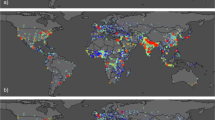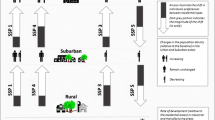Abstract
Planning for the provision of infrastructure and services to accommodate urban growth calls for detailed forecasts of the scale and distribution of housing and population up to 30 years ahead. While a wide range of forecasting methodologies are is use, integrated urban models that link housing demand to land availability and planning constraints by simulating real world processes offer the greatest potential for policy analysis and scenario development. Their major drawbacks lie in extensive data requirements and the specification of realistic modelling parameters. This paper describes a Large Scale Urban Model (LSUM) model developed to predict disaggregate patterns of housing development and population in the rapidly growing region of Southeast Queensland. The LSUM model uses a combination of statistical and dynamic rules to model patterns of housing development across a multi-resolution spatial grid, with aggregate projections constrained to exogenous regional forecasts developed from a suite of demographic models. We outline the main structure of the model, examine key issues in its development, provide illustrative results and explain how it can be employed to explore policy options.
Access this chapter
Tax calculation will be finalised at checkout
Purchases are for personal use only
Similar content being viewed by others
References
ABS (Australian Bureau of Statistics). (2004). Household and family projections, 2001 to 2026 (Catalogue no. 3236.0). Canberra: ABS.
Aerts, J. C., Eisinger, E., Heuvelink, G., & Stewart, T. J. (2003). Using linear integer programming for multi-site land-use allocation. Geographical Analysis, 35(2), 148–169.
Albrechts, L. (2006). Shifts in strategic spatial planning? Some evidence from Europe and Australia. Environment and Planning A, 38(6), 1149–1170.
Anas, A., Arnott, R., & Small, K. A. (1998). Urban spatial structure. Journal of Economic Literature, 36(3), 1426–1464.
Anselin, L. (1995). Local indicators of spatial association – LISA. Geographical Analysis, 27(2), 93–115.
Batty, M. (2004). Dissecting the streams of planning history: Technology versus policy through models. Environment and Planning B, 31(3), 326–330.
Batty, M. (2013). The new science of cities. Cambridge: MIT Press.
Chhetri, P., Stimson, R., Cooper, J., Corcoran, J., Bell, M., & Pullar, D. (2007). Subjectively weighted development scenarios for urban allocation: A case study of South East Queensland. Transactions in GIS, 11(4), 597–619.
Clarke, K. C., Hoppen, S., & Gaydos, L. (1997). A self-modifying cellular automaton model of historical urbanization in the San Francisco Bay area. Environment and Planning B, 24(2), 247–261.
Commonwealth of Australia. (2005). Sustainable cities. Canberra: Australian Government.
Couclelis, H. (2005). Where has the future gone? Rethinking the role of integrated land-use models in spatial planning. Environment and Planning A, 37(8), 1353–1371.
Engelen, G., White, R., & Uljee, I. (1997). Integrating constrained cellular automata models, GIS and decision support tools for urban planning and policy-making. In H. Timmermans (Ed.), Decision support systems in urban planning (pp. 125–155). London: E&FN Spon.
Ettema, D. (2011). A multi-agent model of urban processes: Modelling relocation processes and price setting in housing markets. Computers, Environment and Urban Systems, 35(1), 1–11.
Galster, G., Hanson, R., Ratcliffe, M., Wolman, H., Coleman, S., & Freihage, J. (2001). Wrestling sprawl to the ground. Housing Policy Debate, 12(4), 681–717.
Heppenstall, A. J., Crooks, A. T., See, L. M., & Batty, M. (2012). Agent-based models of geographical systems. Dordrecht: Springer.
Hilferink, M., & Rietveld, P. (1999). Land use scanner: An integrated GIS based model for long term projections of land use in urban and rural areas. Journal of Geographical Systems, 1(2), 155–177.
Holm, M., & Lundquist, L. (1977). Spatial allocations of housing programmes: A model of accessibility and space utilization. Papers of the Regional Science Association, 38(1), 149–168.
Hunt, J. D., Kriger, D. S., & Miller, E. J. (2005). Current operational urban land-use–transport modelling frameworks: A review. Transport Reviews, 25(3), 329–376.
Irwin, E. G., & Bockstael, N. E. (2004). Land use externalities, open space preservation, and urban sprawl. Regional Science and Urban Economics, 34(6), 705–725.
Jantz, C. A., & Goetz, S. J. (2005). Analysis of scale dependencies in an urban land-use-change model. International Journal of Geographical Information Science, 19(2), 217–241.
Kirkpatrick, S., Gelatt, C., & Vecchi, M. (1983). Optimization by simulated annealing. Science, 220(4598), 671–680.
Koomen, E., & Borsboom-van Beurden, J. (2011). Land-use modelling in planning practice. Dordrecht: Springer.
Landis, J. (1995). Imagining land use futures. Journal of the American Planning Association, 16(1), 438–457.
Landis, J., & Zhang, M. (1998). The second generation of the California urban futures model. Part 1: Model logic and theory. Environment and Planning B, 25(5), 657–666.
Malczewski, J. (2004). GIS-based land-use suitability analysis: A critical overview. Progress in Planning, 62(1), 3–65.
Miller, E. J. (2009). Integrated urban models: Theoretical prospects. In R. Kitamura, T. Yoshii, & T. Yamamoto (Eds.), The expanding sphere of travel behaviour research. Bingley: Emerald Group Publishing.
Miller, E. J., Hunt, J. D., Abraham, J. E., & Salvini, P. (2004). Microsimulating urban systems. Computers, Environment and Urban Systems, 28(1–2), 9–44.
Queensland Government. (2005). South East Queensland regional plan 2005–2026. Brisbane: Office of Urban Management.
Queensland Government. (2014). Queensland Government population projections (2013th ed.). Brisbane: Queensland Government Statistician’s Office, Queensland Treasury and Trade.
Riguelle, F., Thomas, I., & Verhetsel, A. (2007). Measuring urban polycentrism – A European case study and its implications. Journal of Economic Geography, 7(2), 193–215.
Stimson, R., Bell, M., Corcoran, J., & Pullar, D. (2012). Using a large scale urban model to test planning scenarios in the Brisbane-south east Queensland region. Regional Science Policy and Practice, 4(4), 373–392.
Timmermans, H. (2003). The saga of integrated land use-transport modeling: How many more dreams before we wake up? In 10th international conference on travel behaviour research, Lucerne.
Verburg, P. H., Schot, P. P., Dijst, M. J., & Veldkamp, A. (2004). Land use change modelling: Current practice and research priorities. GeoJournal, 61(4), 309–324.
Waddell, P. (2000). A behavioral simulation model for metropolitan policy analysis and planning: Residential location and housing market components of UrbanSim. Environment and Planning B, 27(2), 247–263.
Wattelar, C. (2006). Demographic projections: History of the methods and current methodology. In G. Caselli, J. Vallin, & G. Wunsch (Eds.), Demography: Analysis and synthesis (pp. 149–160). San Diego: Academic.
Wegener, M. (1994). Operational urban models: State of the art. Journal of the American Planning Association, 60(1), 17–29.
Wegner, M. (2011). From macro to micro – How much micro is too much? Transportation Reviews: A Transnational Transdisciplinary Journal, 31(2), 161–177.
White, R., Engelen, G., & Uljee, I. (1997). The use of constrained cellular automata for high-resolution modelling of urban land-use dynamics. Environment and Planning B, 24, 323–343.
Wilson, T. (2013). The sequential propensity household projection model. Demographic Research, 28(24), 681–712.
Wilson, T., & Cooper, J. (2013). Overview of the new Queensland demographic projection systems. Research note. Brisbane: Queensland Centre for Population Research, The University of Queensland.
Wilson, T., & Rees, P. (2005). Recent developments in population projection methodology: A review. Population, Space and Place, 11(5), 337–360.
Wu, F., & Webster, C. J. (2000). Simulating artificial cities in a GIS environment: Urban growth under alternative regulation regimes. International Journal of Geographical Information Science, 14(7), 625–648.
Acknowledgments
This chapter is based on research funded by Australian Research Council Linkage grant. LP0453563 with additional support from the industry partner, the Office of Economic and Statistical research in the Queensland Treasury. The views expressed in the paper do not necessarily reflect Queensland government policy.
Author information
Authors and Affiliations
Corresponding author
Editor information
Editors and Affiliations
Rights and permissions
Copyright information
© 2016 Springer International Publishing Switzerland
About this chapter
Cite this chapter
Pullar, D., Bell, M., Cooper, J., Stimson, R., Corcoran, J. (2016). Forecasting Patterns of Metropolitan Growth Using an Optimised Allocation Procedure. In: Wilson, T., Charles-Edwards, E., Bell, M. (eds) Demography for Planning and Policy: Australian Case Studies. Applied Demography Series, vol 7. Springer, Cham. https://doi.org/10.1007/978-3-319-22135-9_7
Download citation
DOI: https://doi.org/10.1007/978-3-319-22135-9_7
Publisher Name: Springer, Cham
Print ISBN: 978-3-319-22134-2
Online ISBN: 978-3-319-22135-9
eBook Packages: Social SciencesSocial Sciences (R0)




